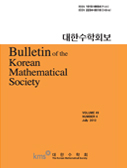Bulletin of the
Korean Mathematical Society
BKMS
Most Read
 VIEW ARTICLES
VIEW ARTICLES
 Most Read
Most Read
-
2022-07-31
On the existence of the Tweedie power parameter implicit estimator
Abdelaziz Ghribi, Aymen Hassin, Afif MasmoudiAbstract : A special class of exponential dispersion models is the class of Tweedie distributions. This class is very significant in statistical modeling as it includes a number of familiar distributions such as Gaussian, Gamma and compound Poisson. A Tweedie distribution has a power parameter $p$, a mean $m$ and a dispersion parameter $\phi$. The value of the power parameter lies in identifying the corresponding distribution of the Tweedie family. The basic objective of this research work resides in investigating the existence of the implicit estimator of the power parameter of the Tweedie distribution. A necessary and sufficient condition on the mean parameter $m$, suggesting that the implicit estimator of the power parameter $p$ exists, was established and we provided some asymptotic properties of this estimator.
-
2023-01-31
Lens spaces admitting minimal symplectic fillings with the second Betti number one
Heesang Park, Dongsoo ShinAbstract : We classify lens spaces with the Milnor fillable contact structure that admit minimal symplectic fillings whose second Betti numbers are one.
-
2023-07-31
Dynamics of random dynamical systems
Enkhbayar Azjargal, Zorigt Choinkhor, Nyamdavaa TsegmidAbstract : In this paper, we introduce the concept of $\omega$-expansive of random map on compact metric spaces $\mathcal{P}$. Also we introduce the definitions of positively, negatively shadowing property and shadowing property for two-sided RDS. Then we show that if $\varphi$ is $\omega$-expansive and has the shadowing property for $\omega$, then $\varphi$ is topologically stable for $\omega$.
-
2023-01-31
Continuous data assimilation for the three-dimensional Leray-$\alpha$ model with stochastically noisy data
Abstract : In this paper we study a nudging continuous data assimilation algorithm for the three-dimensional Leray-$\alpha$ model, where measurement errors are represented by stochastic noise. First, we show that the stochastic data assimilation equations are well-posed. Then we provide explicit conditions on the observation density (resolution) and the relaxation (nudging) parameter which guarantee explicit asymptotic bounds, as the time tends to infinity, on the error between the approximate solution and the actual solution which is corresponding to these measurements, in terms of the variance of the noise in the measurements.
-
2023-01-31
A note on the properties of pseudo-weighted Browder spectrum
Preeti Dharmarha, Sarita KumariAbstract : The goal of this article is to introduce the concept of pseudo-weighted Browder spectrum when the underlying Hilbert space is not necessarily separable. To attain this goal, the notion of $\alpha$-pseudo-Browder operator has been introduced. The properties and the relation of the weighted spectrum, pseudo-weighted spectrum, weighted Browder spectrum, and pseudo-weighted Browder spectrum have been investigated by extending analogous properties of their corresponding essential pseudo-spectrum and essential pseudo-weighted spectrum. The weighted spectrum, pseudo-weighted spectrum, weighted Browder, and pseudo-weighted Browder spectrum of the sum of two bounded linear operators have been characterized in the case when the Hilbert space (not necessarily separable) is a direct sum of its closed invariant subspaces. This exploration ends with a characterization of the pseudo-weighted Browder spectrum of the sum of two bounded linear operators defined over the arbitrary Hilbert spaces under certain conditions.
-
2022-11-30
The $H^1$-uniform attractor for the 2D non-autonomous tropical climate model on some unbounded domains
Pigong Han, Keke Lei, Chenggang Liu, Xuewen WangAbstract : In this paper, we study the uniform attractor of the 2D non-autonomous tropical climate model in an arbitrary unbounded domain on which the Poincar\'e inequality holds. We prove that the uniform attractor is compact not only in the $L^2$-spaces but also in the $H^1$-spaces. Our proof is based on the concept of asymptotical compactness. Finally, for the quasiperiodical external force case, the dimension estimates of such a uniform attractor are also obtained.
-
2023-09-30
Complex symmetric weighted composition-differentiation operators on $H^2$
Lian Hu, Songxiao Li, Rong YangAbstract : In this paper, we study the complex symmetric weighted composition-differentiation operator $D_{\psi,\phi}$ with respect to the conjugation $ JW_{\xi, \tau}$ on the Hardy space $H^2$. As an application, we characterize the necessary and sufficient conditions for such an operator to be normal under some mild conditions. Finally, the spectrum of $D_{\psi,\phi}$ is also investigated.
-
2023-01-31
Homology and Serre class in $\mathrm{D}(R)$
Zhicheng WangAbstract : Let $\mathcal{S}$ be a Serre class in the category of modules and $\mathfrak{a}$ an ideal of a commutative Noetherian ring $R$. We study the containment of Tor modules, Koszul homology and local homology in $\mathcal{S}$ from below. With these results at our disposal, by specializing the Serre class to be Noetherian or zero, a handful of conclusions on Noetherianness and vanishing of the foregoing homology theories are obtained. We also determine when $\mathrm{Tor}_{s+t}^R(R/\mathfrak{a},X)\cong\mathrm{Tor}_{s}^R(R/\mathfrak{a},\mathrm{H}_{t}^\mathfrak{a}(X))$.
-
2022-11-30
Hopf hypersurfaces of the homogeneous nearly K\"{a}hler $\mathbb{S}^3\times\mathbb{S}^3$ satisfying certain commuting conditions
Xiaomin Chen, Yifan YangAbstract : In this article, we first introduce the notion of commuting Ricci tensor and pseudo-anti commuting Ricci tensor for Hopf hypersurfaces in the homogeneous nearly K\"{a}hler $\mathbb{S}^3\times\mathbb{S}^3$ and prove that the mean curvature of hypersurface is constant under certain assumptions. Next, we prove the nonexistence of Ricci soliton on Hopf hypersurface with potential Reeb vector field, which improves a result of Hu et al.~on the nonexistence of Einstein Hopf hypersurfaces in the homogeneous nearly K\"{a}hler $\mathbb{S}^3\times\mathbb{S}^3$.
-
2022-07-31
Knots in homology lens spaces determined by their complements
Abstract : In this paper, we consider the knot complement problem for not null-homologous knots in homology lens spaces. Let $M$ be a homology lens space with $H_1(M; \mathbb{Z}) \cong \mathbb{Z}_p$ and $K$ a not null-homologous knot in $M$. We show that, $K$ is determined by its complement if $M$ is non-hyperbolic, $K$ is hyperbolic, and $p$ is a prime greater than 7, or, if $M$ is actually a lens space $L(p,q)$ and $K$ represents a generator of $H_1(L(p,q))$.

Most Read
-
On complete convergence for weighted sums of coordinatewise negatively associated random vectors in Hilbert spaces
Vu Thi Ngoc Anh, Nguyen Thi Thanh Hien

Bull. Korean Math. Soc. 2022; 59(4): 879-895
https://doi.org/10.4134/BKMS.b210509 -
Blow up of solutions for a Petrovsky type equation with logarithmic nonlinearity
Jorge Ferreira, Nazl\i \, Irk\i l, Erhan Pi\c{s}kin, Carlos Raposo
 , Mohammad Shahrouzi
, Mohammad ShahrouziBull. Korean Math. Soc. 2022; 59(6): 1495-1510
https://doi.org/10.4134/BKMS.b210853 -
Strong classification of extensions of classifiable $C^{*}$-algebras
S{\o}ren Eilers, Gunnar Restorff, Efren Ruiz
Bull. Korean Math. Soc. 2022; 59(3): 567-608
https://doi.org/10.4134/BKMS.b210047 -
Rings and modules which are stable under nilpotents of their injective hulls
Nguyen Thi Thu Ha
Bull. Korean Math. Soc. 2023; 60(2): 339-348
https://doi.org/10.4134/BKMS.b220123
Most Downloaded
-
Automorphisms of K3 surfaces with Picard number two
Kwangwoo Lee
Bull. Korean Math. Soc. 2023; 60(6): 1427-1437
https://doi.org/10.4134/BKMS.b220371 -
$p$-Biharmonic hypersurfaces in Einstein space and conformally flat space
Ahmed Mohammed Cherif, Khadidja Mouffoki
Bull. Korean Math. Soc. 2023; 60(3): 705-715
https://doi.org/10.4134/BKMS.b220347 -
Stability and topology of translating solitons for the mean curvature flow with the small $L^m$ norm of the second fundamental form
Eungmo Nam, Juncheol Pyo
Bull. Korean Math. Soc. 2023; 60(1): 171-184
https://doi.org/10.4134/BKMS.b220049 -
Sharp inequalities involving the Chen-Ricci inequality for slant Riemannian submersions
Mehmet Akif Akyol, Nergiz (Önen) Poyraz
Bull. Korean Math. Soc. 2023; 60(5): 1155-1179
https://doi.org/10.4134/BKMS.b220514
Editorial Office
BKMS
© 2022. The Korean Mathematical Society. Powered by INFOrang Co., Ltd






